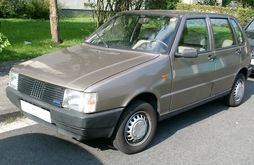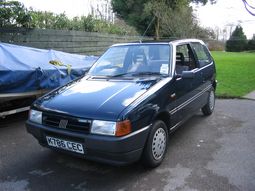The History Of FIAT UNO

The Fiat Uno is a supermini car produced by the Italian manufacturer Fiat. The Uno was launched in 1983 and built in its homeland until 1995, with production still taking place in other countries.
The Uno was launched to replace the ageing Fiat 127. Designed by Giorgetto Giugiaro's ItalDesign company, its tall, square body and a low drag coefficient of 0.34 won it much praise for airy interior space and fuel economy. It incorporated many packaging lessons learnt from Giugiaro's 1978 Lancia Megagamma concept car (an experimental MPV) but miniaturised. It was voted European Car of the Year in 1984.
Initially, the Uno was offered with the 0.9litre (903cc) OHV, 1.1litre (1116cc), and 1.3litre (1301cc) 138-series SOHC petrol engines.The 1.3 (1300cc) diesel (not for the UK market) engine was launched a couple of months later. The Uno's badging was not by the commonly used measurement of engine size but by bhp: 45, 55, 60, 75 or 90. The Uno was available as either a 3- or 5-door hatchback. It also featured unusual "pod" switchgear cluster around the main instrument binnacle, although indicators remained on a stalk; an unusual arrangement notably also used by Citroen.
The Uno had MacPherson strut independent front suspension and beam axle rear suspension with telescopic dampers and coil springs.
From 1985, the new 1.0litre (999cc) SOHC Fully Integrated Robotised Engine (FIRE) powerplant was offered. This was a lighter engine and gave improved performance and economy. Also in 1985, the hot hatch version - Uno Turbo - was launched, with an IHI turbocharged Ritmo/ Strada-derived 1.3 146-series engine, initially offering 105bhp (78kW). It was priced to compete with the Peugeot 205 GTI.
In 1987, a 1.7litre diesel engined version - the 60DS -was launched.
Also in 1987, the Uno Selecta continuously variable transmission (CVT) automatic was launched. This was a co-development with Ford of the Dutch Van Doorne gearbox as used by DAF and later, Volvo.
In September 1989, the Uno was given a major facelift, which saw updated bodywork at the nose and a different tailgate, that improved the drag coefficient to Cd0.30. The interior was also revised. The pod switchgear was replaced by stalks and an effort was made to stop the dashboard rattles of the Mark I. At this time, the old 1.1litre engine was replaced by a new FIRE version, and a new Fiat Tipo-derived 1.4litre engine replaced the Ritmo/ Strada-derived 1.3litre in both naturally aspirated and turbo versions. The Uno Turbo i.e. variant was also restyled, upgraded with a Garret T2 turbine, Bosch LH Jetronic fuel injection and better aerodynamics.
Uno production ceased in Italy in 1995, with sales throughout Western Europe stopping at the same time. A total of 6,032,911 units were built in Fiat's Italian factories. The Uno's replacement in Western Europe was the Fiat Punto, which had been launched in early 1994.
Petrol
Diesel
After Western European production and sales ceased, the Uno continued to be manufactured and sold in many other regions.
South Africa
In South Africa, the Uno was assembled under licence by Nissan from 1990 until 1998 and then by Fiat from 1998 up until 2006. Unos manufactured by Nissan had the word licence underneath the Fiat badge on the rear end and models included the 1100 cc FIRE as well as the 1400cc PACER, PACER SX and TURBO. There were also a number of special editions produced including the Beat and the Rio, these also featured the 1400 engine. After Fiat re-entered South Africa in 1998 Unos were rebadged as either the 1100 Mia or 1400 Tempo. They also featured the Fiat centenary badge from that point on. By the time initial production of the Uno ended in 2006 only the 3 door Mia was available for sale. 110,000 units were produced between 1990 and 2002.
In 2007, the Fiat Uno was redesigned and it re-entered the South African new car market. The car was now marketed and distributed by Fiat themselves. The model line-up includes the Uno Way, which has a higher suspension and colour-coded bumpers than the regular Uno. It is based on the 1983-1990 design, and is powered by a 1.2-litre 4-cylinder petrol engine.
Poland
Production in Fiat's factory in Poland ran until 2002. 173,382 units were built from June 1995 to October 2002.
Brazil
The car is still sold in Brazil, where a saloon version called the Prêmio (exported also as Duna), and an estate called the Fiat Elba (exported also as Duna Weekend or Innocenti Elba) were also available.
The Fiat Uno family, in Brazil, had a turbocharged 1.4-litre four inline sports version in the early 90's. This car was sold as a normal production vehicle.
Currently, the car is sold as the Fiat Mille, as a budget entry-level model, and received its most recent facelift for the 2004 model year. The 2005 Brazilian range has received a Flex Fuel system, enabling the car to use ethanol or gasoline as fuel, both pure or in any proportion mixture; plus, there is a version fitted for unpaved roads called Mille Way, which includes a more resilient suspension, larger wheels and side protections. From April 1988 until 2006, up to 2,000,000 Fiat Unos were made in Brazil.
Argentina
In Argentina, the Fiat Uno was produced from March 1989 to 2000, 179,767 units were built. A specific saloon version with four doors was also produced from 1988 to 2000. Called Duna or Elba, 257,259 units of this version were built in Fiat's Cordoba plant.
Pakistan
The Fiat Uno is also assembled from Complete knock down (CKD) kits in Pakistan by Raja Motor Company, and the recently upgraded (as of 2006) Brazilian-built right-hand drive Uno's are being exported to South Africa.
Morocco
The Fiat Uno was also assembled in Morocco until 2004 by SOMACA (Société Marocaine des Constructions Automobiles), and remains a popular choice of car for "petit-taxi" use.
The Fiat Uno may make a comeback in a few years, as a model that would sit in between the new 500 and the Punto. If this proceeds, it is to be built on a shortened version of a Punto platform and therefore would be lighter.
United Kingdom
The Uno was quite popular in Britain, with 190,000 Mark I examples sold between 1983 and 1989, but only around 5,000 are reported to be still in circulation.
New Zealand
The Uno was a surprise hit for Fiat in New Zealand as well, where a combination of low prices and well received styling saw over 1000 Unos a year moved right up until the late 1980s, with the 3000th New Zealand Uno being celebrated in December 1988. Few Unos remain on the road in 2008, however, with rust being the most common factor.[citation needed]
A white Uno has been alleged to have been involved in the death of Diana, Princess of Wales, on August 31, 1997. However, the car and its driver have never been traced.
Stolen Fiat Unos were used by the infamous 'Uno Bianca' gang in Italy in the early 1990s; they were easy to steal, as most of them lacked an immobilizer, and being a very common model it was easier to get away after committing robberies.
From Wikipedia, the free encyclopedia
More About FIAT UNO




|